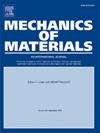具有随机球体孔洞的多孔金属的梯度塑性模型:理论与应用
IF 3.4
3区 材料科学
Q2 MATERIALS SCIENCE, MULTIDISCIPLINARY
引用次数: 0
摘要
这项工作涉及的是一个速率无关的,隐式梯度塑性模型的发展,该模型适用于多孔金属材料,包括具有随机取向的球体孔洞各向同性分布的微结构。我们通过一个单一的常数,即空隙宽高比来考虑空隙形状的影响,该常数可以用作模型的校准参数。非局部公式引入了一个特征材料长度,它作为一个正则化参数,可以通过与手边材料的微观结构尺寸相关联来估计。仔细研究了由此产生的非局部问题的数学特征和椭圆性损失的条件。我们通过解析和数值方法表明,所提出的模型保留了控制方程的椭圆性质,并且可以在分岔后(软化)状态下提供与网格无关的数值解。分析还表明,临界局部应变随孔隙形状的增大而增大。在有限元软件ABAQUS中实现该模型,可以通过工业相关问题的数值模拟来研究各种参数的影响,例如圆柱杆的杯锥断裂和Charpy v型缺口试验。通过回顾第一次桑迪亚压裂挑战,我们展示了该模型在保持可管理的校准参数数量的同时,充分再现真实实验结果的能力。本文章由计算机程序翻译,如有差异,请以英文原文为准。
A gradient plasticity model for porous metals with random spheroidal voids: Theory and applications
This work deals with the development of a rate-independent, implicit gradient plasticity model for porous metallic materials comprising microstructures with an isotropic distribution of randomly oriented spheroidal voids. We take into account void shape effects via a single constant, the void aspect ratio, which can be used as a calibration parameter for the model. The non-local formulation introduces a characteristic material length, which serves as a regularization parameter and can be estimated by association to a microstructural dimension of the material at hand. The mathematical character of the resulting non-local problem and the conditions for loss of ellipticity are carefully examined. We show, both analytically and numerically, that the proposed model retains the elliptic properties of the governing equations and can provide mesh-independent numerical solutions in the post-bifurcation (softening) regime. This analysis also indicates that the critical localization strain is an increasing function of the void shape. Implementation of the model in the finite element software ABAQUS allows to investigate the effects of the various parameters through the numerical simulation of industrially relevant problems such as the cup-and-cone fracture of cylindrical bars and the Charpy V-notch test. By revisiting the first Sandia Fracture Challenge, we showcase the capability of the model to sufficiently reproduce real-world experimental results while maintaining a manageable number of calibrated parameters.
求助全文
通过发布文献求助,成功后即可免费获取论文全文。
去求助
来源期刊

Mechanics of Materials
工程技术-材料科学:综合
CiteScore
7.60
自引率
5.10%
发文量
243
审稿时长
46 days
期刊介绍:
Mechanics of Materials is a forum for original scientific research on the flow, fracture, and general constitutive behavior of geophysical, geotechnical and technological materials, with balanced coverage of advanced technological and natural materials, with balanced coverage of theoretical, experimental, and field investigations. Of special concern are macroscopic predictions based on microscopic models, identification of microscopic structures from limited overall macroscopic data, experimental and field results that lead to fundamental understanding of the behavior of materials, and coordinated experimental and analytical investigations that culminate in theories with predictive quality.
 求助内容:
求助内容: 应助结果提醒方式:
应助结果提醒方式:


